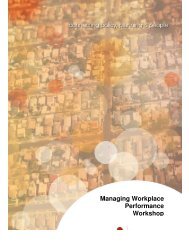Teenage Pregnancy Research Report - 3p Consulting
Teenage Pregnancy Research Report - 3p Consulting
Teenage Pregnancy Research Report - 3p Consulting
Create successful ePaper yourself
Turn your PDF publications into a flip-book with our unique Google optimized e-Paper software.
Information needs of teenage mothersThe questionnaire explored issues that teenagers wouldlike included in antenatal education – topics affectingchildbirth and child care were of greatest interest.The topics on substance use, diet and nutrition and sexualhealth were of least interest. At interview, teenagersprovided support for the importance of preparing fordelivery and parenting: ‘I think they just want to knowwhat it’s going to be like when they have the wain… Ithink they would like to know everything about pain relief,everything I found out… exercises after you had the wain’(two). ‘I needed the information about, like, about caringfor her, like how to feed her and how to wind her and hernappies changed and all that’ (one).Views of teenage mothers who attended theclassesThis section of the questionnaire was only completedby teenagers who had attended the classes. Antenatalclasses were held in a variety of settings, within thecommunity and hospital. Unanimously, teenagers foundtravel problematic and local classes preferable: ‘I endedup going to the ones in the *** Health Centre ’cause theclinic, the antenatal care, is all up the stairs there. Youdon’t have to come down to the hospital… I just stayeddown the road from it’ (one). ‘I feel it should have been inmy local area but I had to go to ***, I live in *** so it meanta bus journey when you’ve got a big massive bump… Ifeel it should have been more local’ and ‘just really travel,that’s one of the main things’ (four). All the teenagers feltthe information given at the classes was ‘at a good level’.They were asked about what topics were covered. Painrelief was identified as most important, while asking aquestion was least enjoyed: ‘The pain relief was a goodone and then your exercises. They two were the main onesthat I really listened to’ (four). ‘Pain relief during labour,the labour, like the posture, the way you’d to sit… caringfor your baby when they’re born and all that’ (one). Onequestionnaire respondent did not like talking about thingsthat could go wrong. However, an interviewee specificallywanted to know more about problems or poor outcomes:‘I think more bad issues should be included… ’cause wedid talk about, like, stillborn babies, what happens if thiswent wrong… I would have liked to know more about whatcould happen, instead of just like a hunky-dory birthingunit labour’ (four). Fear of the unknown was paramount.These girls needed courage to address their anxieties.DiscussionIt is crucial that the content of antenatal classes shouldbe targeted at teenagers (Rozette et al, 2000). Manyrespondents wanted to know about pain relief and labour,but a small proportion felt it would make no difference tothem. Two wanted to know more about adverse eventsor instrumental deliveries to help them prepare shouldsuch events occur. Not only should the focus be ontopics around ante- and intrapartum care, but the studyalso demonstrated that issues of child care/child health,and postpartum events should be addressed. This ispertinent in helping teenagers develop parenting skillsthrough information that could be related to practical babycare. Participants had little information on sexual healthand contraception.This should be a vital element of classes (Rozette et al,2000) as it may prevent future unintended pregnanciesand give teenagers knowledge and confidence abouttheir bodies. A surprising finding was that manyteenagers did not feel it was important to attend a labourward/birthing unit tour. One reason for this may be thatthey did not know what a tour entailed, so did not feel itwas relevant. If it were explained to them that seeing theenvironment might help them feel less afraid and moreprepared, they could make a more meaningful decision.This might just be a coping mechanism for them to avoidthinking about the event or what it entailed because ofthe ‘fear factor’. Attendance rate at antenatal classesfrom this study was poor, as only nine out of 29 teenagersparticipated. One reason given for non-attendance wasthe feeling of being stigmatised because of their age. Ahigher attendance rate may have been achieved had theclass been arranged specifically for teenagers. Therewas definite agreement from them that they would haveattended such classes. This suggests the importanceof maternity services providing effective and accessibleteenage classes at a time and venue more suitable to theircircumstances. Another factor governing non-attendancewas the teenagers’ attitudes and the likelihood that ‘theyjust could not be bothered’. Evidence from other studies(Slager-Earnest et al, 1987; Smoke and Grace, 1988)highlighted that teenagers’ obstetric outcomes are betterif they attend classes. It is important to find strategies tochange teenagers’ attitudes from negative thoughts aboutantenatal classes, to positive ones about their benefits.This could be difficult to achieve with this population.Carefully worded advertising of the classes maydemonstrate that antenatal classes are neither‘authoritarian’ nor ‘like school’. This may help to changeattitudes, because it would convey to the teenagersthat their views were valued and respected within thematernity services. Although it has been established thatthe teenagers were from a lower socio-economic class,it was evident that more than half the participants livedat home with parents or significant family members who,according to the teenagers, had provided real support. This65



